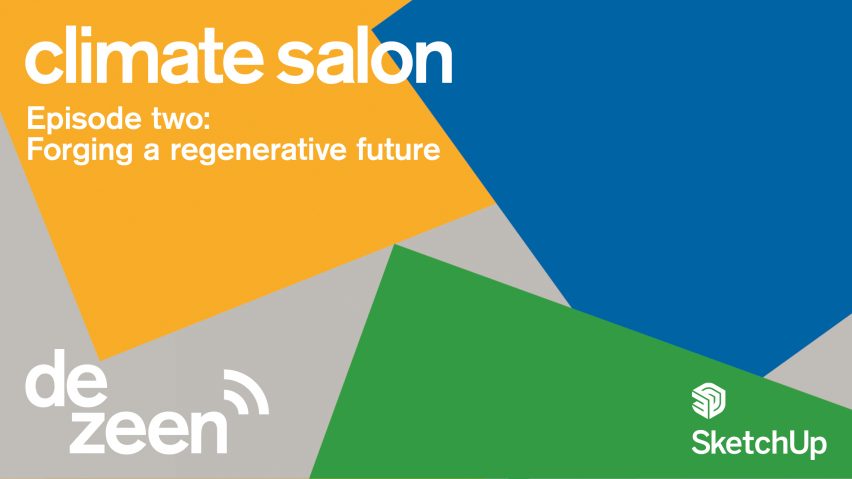An expert panel including designer Sebastian Cox and architect Rikke Juul Gram advocated for a regenerative approach to design and architecture in the second episode of our new Climate Salon podcast series with SketchUp.
Listen to the episode below or subscribe on Apple Podcasts, Spotify and Google Podcasts to catch the whole series.
In the second episode, titled Forging a Regenerative Future, Cox, Gram and Trimble SketchUp's sustainable lead Hugh McEvoy discussed how design and architecture can work in conjunction with nature to have a positive impact on the environment.
Speaking to Jennifer Hahn, host of the podcast series and Dezeen's design and environment editor, the panel explored what the term 'regenerative' means in the context of architecture and design.
Cox, whose furniture business is focussed on restoring biodiversity to the environments from which it harvests materials, suggested that regenerative practices are ones that allow natural environments from which materials are harvested to replenish themselves using naturally occurring processes, in contrast to practices associated with sustainability such as tree planting.
"Sustainability is about offsetting … and just balancing the books. It feels quite technocratic," he said.
"When we start thinking about regenerative design or regenerative construction, architecture, agriculture, it focusses on biodiversity," he continued. "It's about making the habitat better than if we had not intervened to harvest materials."
"It gets us away from just, let's minimise [damage], and into a world of, let's do something that's actually a great experience for people that live there and an upside for the planet," added McEvoy, who is sustainable lead at SketchUp.
The conversation is the second episode of Dezeen and SketchUp's Climate Salon, a podcast series exploring the role that architects and designers can play in tackling climate change.
Across six episodes, Dezeen is speaking to architects, designers and engineers to explore how to better collaborate across their respective disciplines to create a more cohesive response to climate change.
Using existing resources
Gram, who is a partner at Copenhagen landscape architecture firm Schønherr, described how a regenerative approach to urban planning should create spaces for natural systems in cities in order that they are able to perform functions.
She has explored this principle with an urban planning project called Copenhagen Islands, which is presented as part of the Danish Pavilion at the Venice Architecture Biennale, opening later this week.
The project is a proposal for Copenhagen that would allow it to better coexist with rising seawater and rainwater levels by replacing its existing plan with a reconfigured system of islets and sponge-like coastal zones.
"Water is maybe one of our most valuable resources, and we tend to think of it as just something coming out of a tap, or something that we need to defeat because of rising sea waters and too much rain," she said.
"Actually, it's our finest resource to create nature," she continued. "The only thing it needs is something also very precious, which is space. A new way of connecting cities with nature is to release space for the systems."
A new approach to aesthetics
McEvoy proposed that a greater focus from the outset of a project on understanding a building's systems, rather than on its aesthetics, would be required for a more regenerative approach to architecture.
"Historically, there's been a very strong emphasis in architecture on aesthetics," he said. "What happens then is the impact gets neglected."
"Were architectural designers and interior designers to take more interest in understanding how the whole system fits together, they're going to design buildings that perform better, and they're going to be able to preserve the design integrity of the building throughout its whole lifecycle."
Both Cox and Gram advocated for a change in what is considered aesthetically appealing in architecture and design.
"We need to transform our toolbox, as designers, in terms of what is actually beautiful," said Gram. "We need to have aesthetic research at the same time as functional research, looking at new materials."
"You can build into your design and into your systems of production, and into your clients and their cultural attitudes, a degree of tolerance for the imperfection, or an understanding that variation is to be welcomed," offered Cox.
Each episode of the Climate Salon podcast provides insight into how specialists across diverse disciplines can work in conjunction to mitigate the effects of climate change.
Produced by Dezeen's in-house creative team, Climate Salon episodes will be released over the coming months along with opinion pieces by SketchUp relating to the topics featured in the series.
The second episode is now available to download to coincide with the launch of the Venice Architecture Biennale. Subscribe now on Spotify, Apple Podcasts or Google Podcasts to make sure you don't miss an episode.
SketchUp is a piece of 3D design software used to model architectural and interior design projects, product designs, civil and mechanical engineering and more. It is owned by construction technology company Trimble.
Partnership content
The Climate Salon podcast is produced by Dezeen in partnership with SketchUp. Find out more about Dezeen partnership content here.

